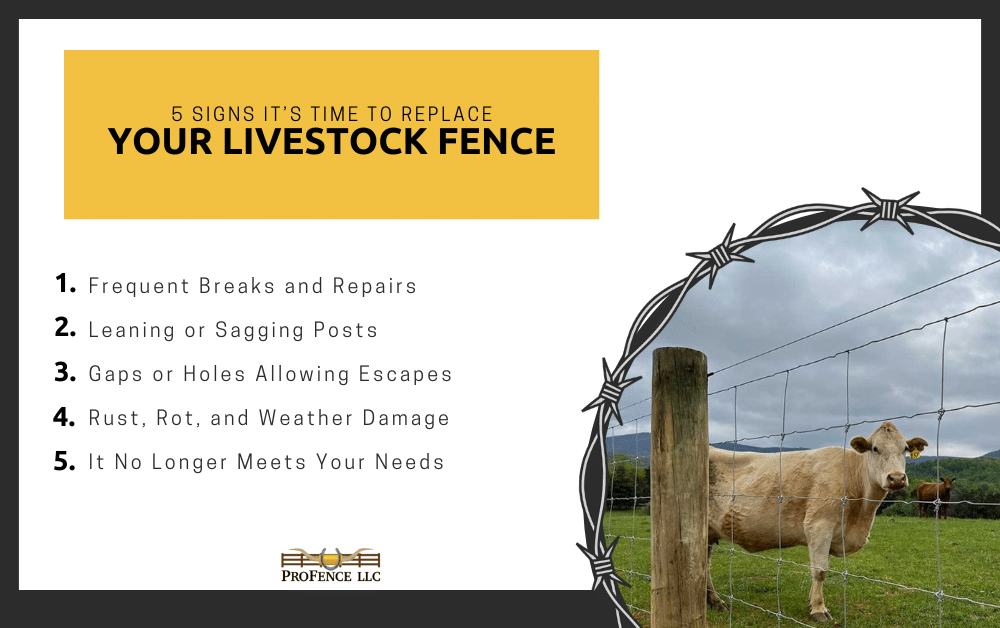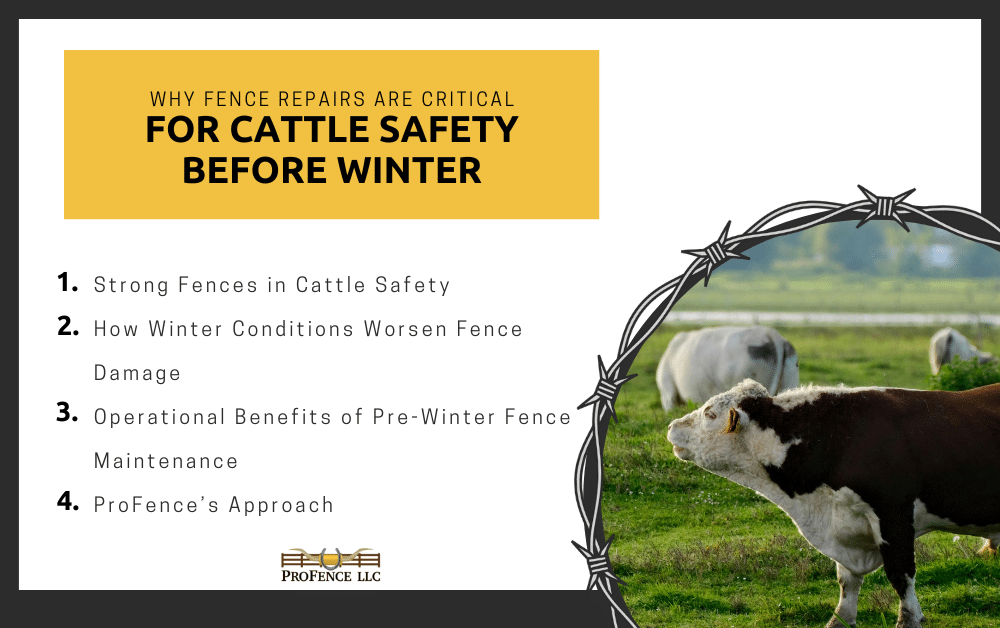Your livestock fence is more than just a property line — it’s the first line of defense for your animals’ safety, your crops’ protection, and your farm’s overall efficiency. Whether you’re raising cattle, goats, sheep, or horses, a sturdy and reliable fence ensures that your animals stay where they belong and predators stay out.
Over time, even the best-built fences can wear down from weather, animal pressure, and simple age. While minor repairs can keep a fence going for a while, there comes a point when replacing it entirely is the smarter, safer, and more cost-effective choice.
In this guide, we’ll walk you through the five biggest signs it’s time to replace your livestock fence—before a small issue becomes a costly problem.
Sign #1 – Frequent Breaks and Repairs
If you’re finding yourself out in the field every few weeks to patch up yet another broken section of your livestock fence, it’s a red flag.
Recurring Damage
Small breaks here and there are normal, but constant repairs suggest the fence material is beyond its lifespan. Wires lose tension, boards splinter, and fasteners loosen with repeated strain.
Material Fatigue
- Wood fences can rot, split, or warp from moisture and temperature changes.
- Metal fencing can rust, weakening its structure and reducing its ability to hold tension.
- Electric fencing can lose conductivity as wires corrode or connections weaken.
Hidden Costs
What many farmers don’t realize is how quickly frequent repairs add up. Each trip to the store for supplies, each hour of labor, and each patch that doesn’t last all eat into your budget.
Sign #2 – Leaning or Sagging Posts
A livestock fence is only as strong as its posts. When posts start leaning or sagging, the entire structure loses integrity.
Structural Weakness
Leaning posts create loose wires or gaps between boards, allowing animals to push through. Once a post shifts, tension is compromised across a much larger section of the fence.
Soil Erosion
Wet areas, poor drainage, or steep slopes can cause soil to shift, making posts unstable.
Animal Pressure
Livestock rubbing or leaning against fence posts—especially cattle and horses—accelerates wear.
Common Causes of Leaning Posts:
- Poor installation or shallow post depth
- Rotting post bases
- Ground movement from frost/thaw cycles
- Constant livestock pressure
Sign #3 – Gaps or Holes Allowing Escapes
Even the smallest opening in a livestock fence can lead to a major problem.
Animal Safety Risks
An escaped cow or horse near a roadway is a serious safety hazard. Smaller livestock, like goats or sheep, may wander into predator territory.
Crop Damage
If animals break into planted fields or pastures not meant for grazing, it can lead to significant crop loss and costly replanting.
Neighbor Disputes
Escaped animals can damage nearby properties or mix with another farmer’s herd—creating tension or even legal issues.
Sign #4 – Rust, Rot, and Weather Damage
Your livestock fence is exposed to the elements 24/7, and over the years, nature takes its toll.
Metal Fences
Rust weakens structural integrity and can cause wires to snap. In electric fences, corrosion can reduce conductivity, making the fence ineffective.
Wood Fences
Moisture causes rot, while insects like termites can hollow out boards. UV exposure from the sun leads to splintering and cracking.
Weather Impact
Snow and ice add weight that can break boards or sag wires. Heat causes expansion and contraction, loosening fasteners.
Sign #5 – It No Longer Meets Your Needs
Sometimes your livestock fence is in decent shape—but it’s simply not the right fit anymore.
Changes in Livestock
If you’ve switched from sheep to cattle, or added horses, your current fence might not be tall or strong enough.
Land Use Changes
Expanding pastures, adding rotational grazing sections, or creating holding areas may require a different fence layout or material.
Technology Upgrades
Today’s fences offer better predator-proofing, easier maintenance, and improved safety features. From coated high-tensile wire to wildlife-friendly designs, upgrades can save time and labor.
How ProFence Can Help
At ProFence, we’ve spent decades building livestock fences that stand up to real-world farming challenges. Our expert team can assess your property, recommend the right fence type for your animals, and install it to professional standards.
Fence Types We Install:
- Woven Wire: Great for sheep, goats, and cattle.
- High-Tensile: Long-lasting and low-maintenance.
- Board Fences: Aesthetic and safe for horses.
- Electric Fences: Effective for rotational grazing and predator control.
With ProFence, you get:
- Custom designs for your land and livestock
- Durable materials built to last decades
- Professional installation that saves you time and frustration
Don’t Wait for a Fence Failure — Protect Your Livestock Now
A failing livestock fence isn’t just an inconvenience—it’s a risk to your animals, your livelihood, and your peace of mind. By watching for these five warning signs—frequent repairs, leaning posts, gaps, weather damage, and outdated design—you can address problems before they escalate.
Don’t wait until you’re chasing escaped cattle at midnight. Let ProFence help you choose a fence that’s secure, durable, and designed for your farm’s unique needs.
Call us today or request a free online estimate. Your livestock’s safety starts with the right fence.







